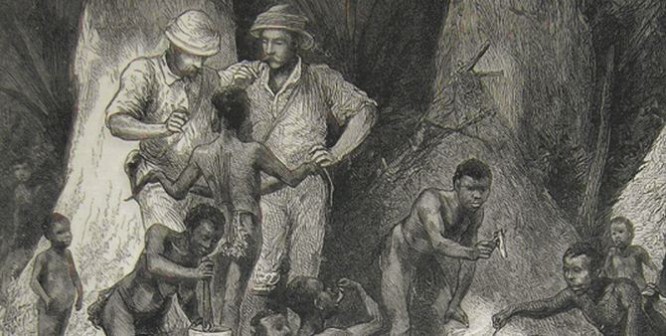Near the end of the 19th century, Europe’s colonial powers were still convinced Africa was a game bird to be carved and shared. Land was raped for resources; people enslaved for labor. It was grim and deadly, and one of the few frontiers where spoiled aristocrats could still pay to have an adventure.
This is the story of the Jameson Cannibal Affair.
James Sligo Jameson, heir to the Jameson whiskey fortune, bought his way into the heart of darkness in 1888. His explicit job was as a subcommander in the rear column of a Belgian relief expedition, but he wasn’t much interested in leading, and the unit fell into disarray under his supervision.
Instead, Jameson was darkly fascinated with the customs of the Congo natives, especially their penchant for cannibalism. The macabre eating habits had been widely documented, right down to the gleaming points at the end of the natives’ sharpened teeth. In his own letters, Jameson recounts the common recipe – Wash bodies; Stuff bodies with bananas; Roast bodies. Serve bodies.
But something in Jameson wouldn’t rest. Inside him curiosity widened a black cavity he couldn’t fill with secondhand accounts.
See, Jameson himself had never seen man eat man. And what self-respecting tourist would miss the chance to confirm, with his own eyes, the sordid rumors whispered in parlors by wide-eyed women in corsets, grimly speculated by dapper gents between brandy apertifs?
This is where accounts of the affair dovetail. Some say Jameson asked to see cannibalism first-hand and asked what it would cost. Like it was the toll on the Liberty ferry. In his own accounts, released posthumously by his wife, Jameson says he thought the whole thing was a ruse, a trick the tribe was playing on the foreigner, and he wanted to see the punchline.
What is agreed upon is the price of six handkerchiefs. That is what James Jameson paid to see a 10-year-old girl from a rival village procured, tied to a tree, and stabbed twice in the torso. The cannibals beheaded her, carved her up with practiced efficiency, and took her in parts to the river for washing. The complete mise-en-place.
“The most extraordinary thing,” Jameson wrote, “was that the girl never uttered a sound, nor struggled until she fell. … When I went home I tried to make some small sketches of the scene while still fresh in my memory, not that it is every like to fade from it. No one here seemed to be in the least astonished at it.”
With the whole of the expedition failing spectacularly, word trickled back to civilization. Stomachs and public opinion turned.Jameson became a poster boy for Africa’s capacity to bankrupt a man’s morality.a He died of illness before he was held accountable.
For six handkerchiefs, Jameson got what he paid for; humanity tied, sliced, torn, stuffed and spitted. The devil’s price is always cheapest.
